|
|
| Home - Software M&A Review - Jul 04 Issue |
Software M&A - A Glimpse into the Second Quarter |
By Ken Bender, Managing Director, and Allen Cinzori, Vice President - Software Equity Group, LLC
ECONOMY
The U.S. economy showed continued strength in the second quarter, but not all signs were positive. Gross Domestic Product (GDP), a key economic indicator and broadest measure of economic activity, is projected to grow at a healthy annualized rate of 4.4% in 2Q04. First quarter GDP, however, was revised downward by 0.5% to 3.9% due to weaker exports and a decline in business spending (Figure 1). According to a midyear survey of 55 forecasters by The Wall Street Journal, economists are moderately bullish on the economy's prospects, projecting 4.4% growth in 3Q04 and 4.2% in 4Q04. Personal consumption, exports, equipment and software expenditures, inventory investment and federal government spending are likely to be the key drivers. Industrial sector growth is expected to outweigh consumer-related growth.
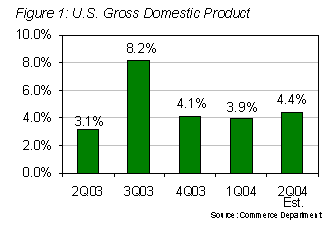
The Conference Board's index of leading economic indicators, which gauges the economy's likely performance over the next three to six months, also forecasts a robust economy and continued expansion. The index, which grew 0.1% in April and 0.5% in May, has advanced 13 of the past 14 months. May results reflected an increase in eight of the 10 indicators used to derive the index, with consumer confidence and stock prices the only exceptions. The Board's index of coincident indicators, a gauge of current economic activity, rose 0.3% in May and an equivalent amount in April. The index tracks payrolls, incomes, sales and production. After dropping in May, consumer confidence took a surprising leap in June, reaching the highest level since mid-2002, as consumers became more confident in a sustained economic recovery.
Despite this positive news, rising interest rates, skyrocketing oil prices and fuel costs, the war in Iraq and looming U.S. Presidential elections cast their shadow on the economy and set a sober tone on Wall Street. The Federal Reserve, to no one's surprise, raised the federal funds rate 25 basis points to 1.25% to check inflation and keep the economy from overheating. The funds rate had been at 1% since early 2003 - its lowest level since 1958 - as the Fed fought to stimulate an economy battered by a plunging stock market, a recession, terrorist attacks and war. Most economists expect a series of fund rate increases in the coming months, likely reaching 2% by the end of 2004 and 3% by mid- 2005, according to the Bond Market Association's economic advisory committee. High by today's standards, but a far cry from the 6.5% the Federal Reserve instituted in 2001 to slow an "irrationally exuberant" economy.
Although the economy has continued to expand, generating 1.2 million new jobs this year, June's unemployment numbers generated renewed concerns about the health of the labor force. Employers added 112,000 new payroll jobs, considerably fewer than the 250,000 that economists forecasted. Unemployment remained unchanged at 5.6% for the third month. Still, June's increase was the 10th consecutive monthly improvement.
PUBLIC MARKETS
The combination of continuing economic growth, corporate profits, mixed employment signals, interest rate uncertainty, high oil prices and geopolitical instability was almost more than Wall Street could handle. U.S. Markets ended a volatile first half on a slightly positive note, with the Dow, Nasdaq and S&P 500 up 0.3%, 2.1% and 3.0%, respectively. For the quarter, these same indices were up 0.1%, 1.6% and 0.6%, respectively. Market Caps of the SEG-100, our index of public software companies, lagged for most of the second quarter, but improved in June to close up 7.3% over the first quarter and 0.8% relative to the beginning of the year (Figure 2). Other key 2Q04 measures for the SEG-100, including comparisons with the prior quarter, are enumerated in Figure 3.
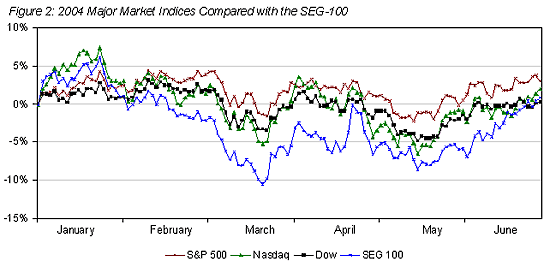
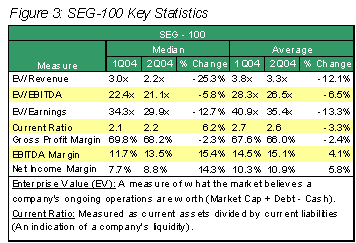
On a trailing-twelve-month revenue (TTM) basis, after factoring in 1Q04 (the latest reported quarter as of this writing), overall financial performance of the SEG-100 improved, in large part due to new license revenue. Median TTM revenue increased 3% in 2Q04 compared to 1Q04, while TTM earnings increased 14.6% over the same period (Figures 4 and 5).
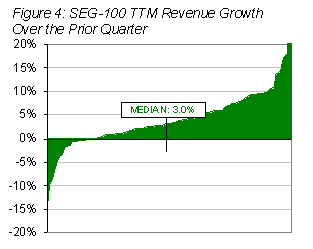
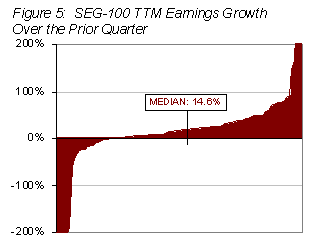
The growth in both revenue and earnings typified companies in every software category. On a TTM basis, revenue growth was strongest in storage management (+7.7%) and business intelligence (+7.3%) with customer relationship management (+0.1%) and CAD/CAE (+0.9%) lagging far behind. Enterprise system management providers increased TTM earnings 57.8%, leading all categories, while business intelligence realized the most modest increase (+0.7%) (Figure 6).
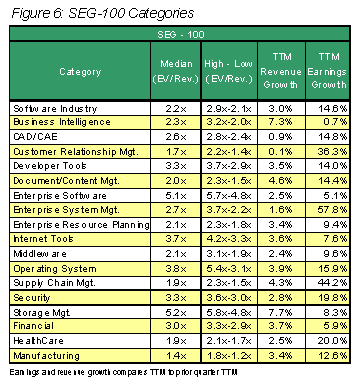
Early reports of 2Q04 revenue by a dozen leading vendors, however, cast a shadow on an otherwise sunny picture. Veritas projected 2Q04 revenue in the $475 to $485 million range (vs. an expected $480 - $505 million) and Sybase estimated 2Q04 revenue would come in at $188 - $192 million (vs. $199 million consensus). Even bigger shortfalls were signaled by Siebel, which estimated its 2Q04 revenue would be $301 million rather than $353 million, as well as BMC ($318 - $ 328 million vs. $345 - $355 million expected) and Compuware ($286 million vs. $313 million). Conversely, SAP reported software sales rose 15% (to $614 million) in the quarter, exceeding analysts" expectations. Cognos and Lawson, which closed their most recent quarters on May 31 also exceeded Wall Street's expectations.
We do not see the revenue shortfall of some as cause for alarm, or as a portent for the remaining two quarters. First, many companies met or exceeded expectations. Second, 1Q04 was an extraordinary quarter which compelled some to set the bar for the following quarter unrealistically high. Though investors were disappointed, it's important to note 7 of the 11 companies which were hammered for missing their 2Q04 estimates expect to report revenue equal or greater than in 1Q04. Further, 2Q04's revenue hiccup was a function of IT spending patterns, rather than IT budget cuts. Recent surveys continue to indicate IT spending will increase in the coming months (see below). And finally, 2Q04 likely reflects the recent imposition of more stringent revenue
recognition policies by many of these vendors.
The markets had fewer concerns about the very largest software vendors (Figure 7). Companies with TTM revenue in excess of $1 billion posted a median 3.7x EV/Revenue ratio compared to a median 2.0x ratio for software companies with revenues less than $1 billion. Investors also remained focused on earnings. The median valuation of SEG 100 companies posting profits in 2Q04 was 3.1x, but only 1.9x for those reporting losses (Figure 8).
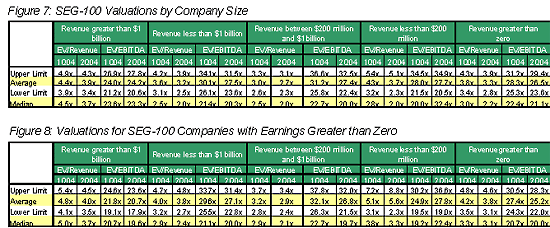
IT spending, a precursor of future software industry financial performance, continued to rebound in 2Q04 and appears poised for further gains in the months ahead. CIO Magazine's Tech Poll, which surveys CIOs in a broad cross section of industries, projected an 8.2% increase in IT budgets in the coming 12 months. According to the survey, much of the spending will be focused on security software, computer hardware, storage management systems, data networking, telecom equipment, eBusiness applications and infrastructure software. Security software, computer hardware and storage systems represent the strongest growth areas with 58%, 56% and 53% of respondents indicating increased budget allocations.
Equally encouraging was Goldman Sachs" May IT spending survey, which indicated 55% of CIOs expect tech capital spending to increase in 2004 by 2.4%, up significantly from the 0.9% projection of December 2003. While less optimistic than CIO Magazine's Tech Poll, the survey projects steady growth in IT spending for both software and hardware. Longer-term, CIOs are anticipating a 5.6% increase. Security, storage management and remote connectivity remain top priorities (Figure 9).
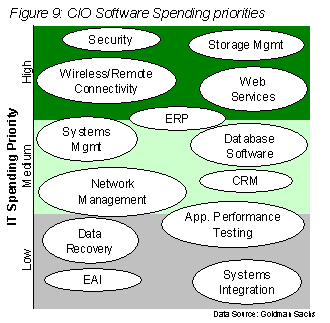
The IPO market, spurred by Google, saw more activity than anytime in the past 4 years. A total of 127 companies filed for initial public offerings in 2Q04, up sharply from the 85 registration statements filed in 1Q04. 2Q04 saw 3 software companies begin trading (Salesforce.com, Blackboard, Motive) as well as 12 new software IPO filings. The trend is a welcome improvement over 1Q04 which had 7 filings and no software companies that began trading. Salesforce.com, a customer relationship management software provider, was the story of the quarter closing its first day of trading up 56% from its offering price despite the company's earnings restatement.
MERGERS & ACQUISITIONS: THE TRENDS
Half-way through the year, three overriding trends in software mergers and acquisitions are discernable:
1. Logical, incremental acquisitions. Buyers today are laser focused, more so than ever before. Virtually every public software company, and every venture-backed software company pursuing growth through acquisitions, has a well-defined acquisition strategy and is sticking to it. "Over the transom" deals are few and far between. Potential sellers able to articulate a compelling value proposition to a prospective acquirer will find it falls on deaf ears, unless the buyer has already had the same thought. Conversely, buyers are increasingly frustrated at the inability to find viable candidates that wholly satisfy their acquisition parameters.
What, precisely, are these acquisition parameters? Are there certain themes buyers today share in common? Indeed. Approximately 2 out of 3 (63%) of the 187 software transactions we analyzed in 2Q04 were deemed "Product Extensions", meaning the buyer sought an almost perfect strategic fit with its current offering and target market (Figure 10). In virtually every case, the acquired company offered highly synergistic products and compatible, incremental, value-added technology. Examples include Symantec's acquisition of high flying anti-spam software developer Brightmail; BMC's purchase of Marimba, a leader in change and configuration management; and workforce management provider WorkStream's acquisition of Kadiri, a compensation management software company. Interestingly, these Product Extension acquisitions comprised precisely the same percentage of all transactions in 2Q04 as they did in 1Q04, with most buyers simply refusing to venture far from home.
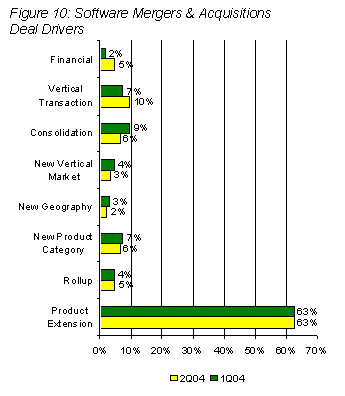
|
|


|

